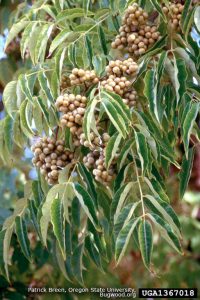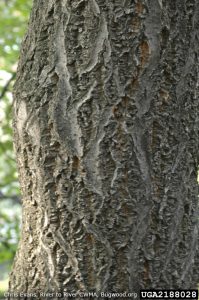Amur Cork Tree
(Phellodendron amurense)
Family: Citrus family (Rutaceae)
Native Range: China, Japan, Korea
 Amur cork tree is a small to medium-sized tree growing 35 to 50 feet in height. It has prominently ridged bark, which is soft and corky to the touch. Just beneath the ridged outer bark, the tree has a bright yellow inner bark. Amur cork tree has compound leaves with 5 to 13 leaflets; the leaves are 10-15 inches in length, and the leaflets are 2.5 to 4.5 inches in length. The leaves turn bright yellow in the fall. Amur cork tree’s small, yellow-green flowers bloom in late May to early June. The flowers develop into clusters of pea-like fruits that change from green to black. The tree is dioecious (individual trees are either male or female) and the fruits only appear on female trees.
Amur cork tree is a small to medium-sized tree growing 35 to 50 feet in height. It has prominently ridged bark, which is soft and corky to the touch. Just beneath the ridged outer bark, the tree has a bright yellow inner bark. Amur cork tree has compound leaves with 5 to 13 leaflets; the leaves are 10-15 inches in length, and the leaflets are 2.5 to 4.5 inches in length. The leaves turn bright yellow in the fall. Amur cork tree’s small, yellow-green flowers bloom in late May to early June. The flowers develop into clusters of pea-like fruits that change from green to black. The tree is dioecious (individual trees are either male or female) and the fruits only appear on female trees.
Reproductive/Dispersal Methods
Reproduction is by seed. The fruits are dispersed by birds and by water currents where the tree occurs near rivers and streams.
Similar Species
Native ash trees (Fraxinus spp.) have compound leaves that resemble those of Amur cork tree. Also, the bark of mature, large white and green ash may be furrowed in a pattern somewhat similar to that of Amur cork tree. Ashes generally have 5-9 leaflets per leaf, while Amur cork tree often has 9-13 or leaflets per leaf (however, they sometimes have fewer than 9 leaflets). The bark of Amur cork tree is more prominently and irregularly ridged than ash bark; only very old ashes, which would be much taller than a cork tree, would have such prominent ridges. The pea-like fruits of Amur cork tree are very different from the narrow, winged, samara fruits of ashes.
Impacts
 Amur cork tree spreads into moist woodlands, thickets, and river floodplains where it can out-compete native trees and shrubs.
Amur cork tree spreads into moist woodlands, thickets, and river floodplains where it can out-compete native trees and shrubs.
Distribution
Amur cork tree is native to northeastern China, Korea, and Japan. In the United States it is distributed in several mid-western states (it is listed as invasive in Illinois) and in eastern states from Virginia to Massachusetts, where it is listed by the Department of Agricultural Resources as a noxious weed.
Sources and Links:
http://www.hort.uconn.edu/plants/detail.php?pid=305
http://www.fs.fed.us/rm/pubs_other/wo_AgricHandbook727/wo_AgricHandbook727_783_785.pdf
http://www.dcnr.state.pa.us/cs/groups/public/documents/document/dcnr_010285.pdf
http://www.na.fs.fed.us/fhp/invasive_plants/weeds/amur-corktree.pdf